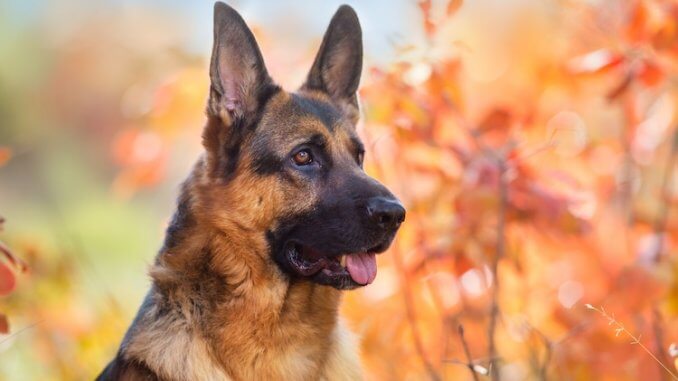
The German shepherd dog is a medium-to-large German working dog. German shepherds grow to 25 inches tall, weigh between 55 and 88 pounds, and live for up to 13 years.
German shepherds are intelligent, obedient dogs that are strongly protective of their owners. Although
German shepherds get along well with children and other pets, the dogs need early socialization and consistent training to become trusted family members.
TABLE OF CONTENTS
German Shepherd Quick Summary
| Breed group | Pastoral group (herding dog) |
| Size | Males: 24–26 inches Females: 22–24 inches |
| Weight | Males: 80–88 pounds Females: 55–77 pounds |
| Coat | Double-coated |
| Color Variations | Black, sable, blue, white, liver (brown), tan, gray, red and black, tan and black |
| Shedding | Heavy |
| Personality | Intelligent, loyal, stubborn, curious, watchful |
| Life Span | 9–13 years |
| Cost | $800–$1,500 |
| Exercise Needs | High: minimum 2 hours of exercise per day |
| Food Needs | High: 1740–2100 daily caloric intake |
| Known Health Conditions | Hip and elbow dysplasia, epilepsy, gastric dilatation-volvulus (GDV) |
| Trainability | Good |
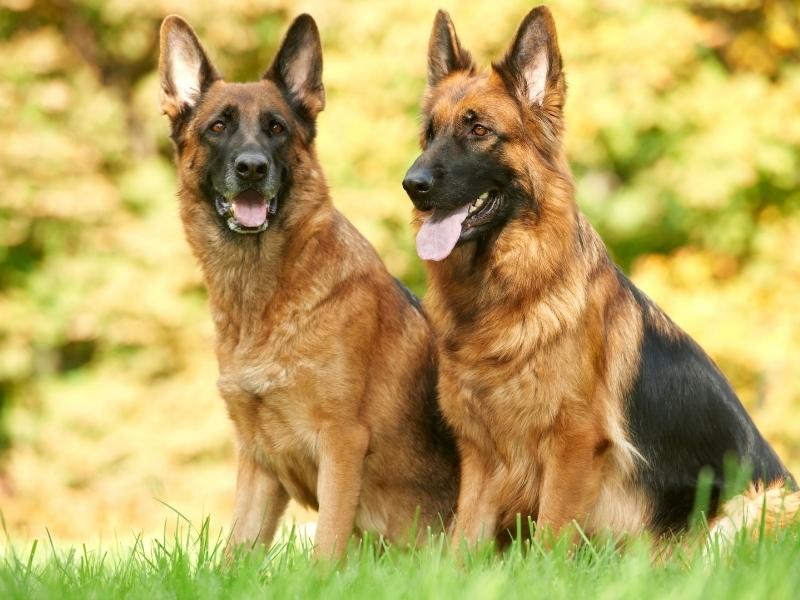
From Adobe Stock
German Shepherd Appearance

From Adobe Stock
German shepherds have thick coats in shades of brown, tan, black, and gray, with black snouts, pointed ears, and long, bushy, downward-curving tails.
German shepherds have stocky bodies with medium-length fur. Long-fur breeds of German shepherds are also available.
Height and Weight
The average height of a male German shepherd is 24 to 26 inches, and female German shepherds grow to 22 to 24 inches tall. A German shepherd’s height is genetic, passed on from the dog’s parents.
Male German shepherds weigh between 80 and 88 pounds, and females weigh between 55 and 77 pounds.
Genetics and diet affect the weight of a German shepherd. Nutritious, high-protein foods allow for healthy weight gain in German shepherds.
German shepherd puppies weigh between 4.5 and 9 pounds and are between 4 and 6 inches tall. The puppies grow and gain weight until they reach full adult size, at three years old.
Coat
German Shepherds have thick, medium or long double coats. The undercoat is a thick, plush layer of short fur, while the outer layer consists of long hairs, called guard hairs, that keep the dog protected from the elements.
The hair on the German shepherd’s ears, head, paws, and toes is short, while the hair on the back of the dog’s legs and on the dog’s tail is long.
Long-coated German shepherds have thick, tufty fur behind their ears, and dense feathering on their hind legs.
German shepherd colors are traditionally black and tan, but the coat can also be gray, silver, or various shades of brown. The most dominant coat color of all German shepherds is the sable German shepherd.
German shepherds often have multi-colored coats, such as black and tan, black and red, or black and silver. White German shepherds are rare. There are also blue German shepherds, and black German shepherds.
Head and Facial Features
The German shepherd has a large, wedge-shaped head proportionate to its body, and a square-cut, elongated muzzle with a black, wide nose.
German shepherds have erect, alert ears with pointed tips. The skull tapers gradually from the ears to the nose, ending in a long snout with strong jaw muscles.
German Shepherd Origins
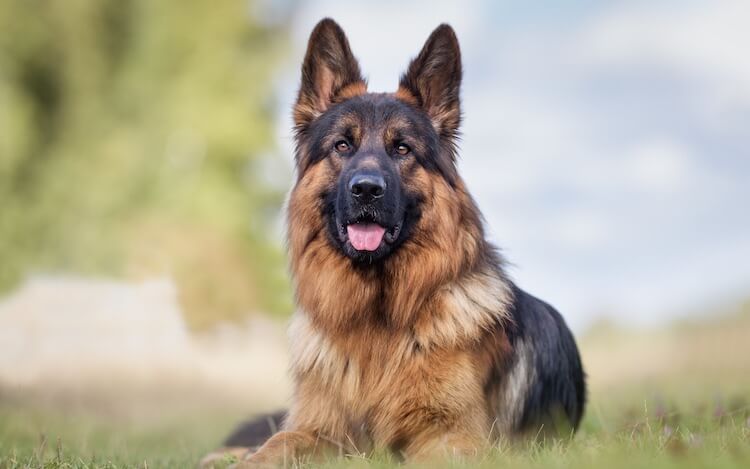
German shepherds originated from shepherd dogs in Germany. The German shepherd was selectively bred in the late 1880s and was originally used as a working dog.
Horand von Grafrath was the first dog to be declared a German shepherd dog in 1899.
Today, German shepherds are still used as working dogs in the public sector due to their intelligence and trainability.
German Shepherd Personality and Temperament
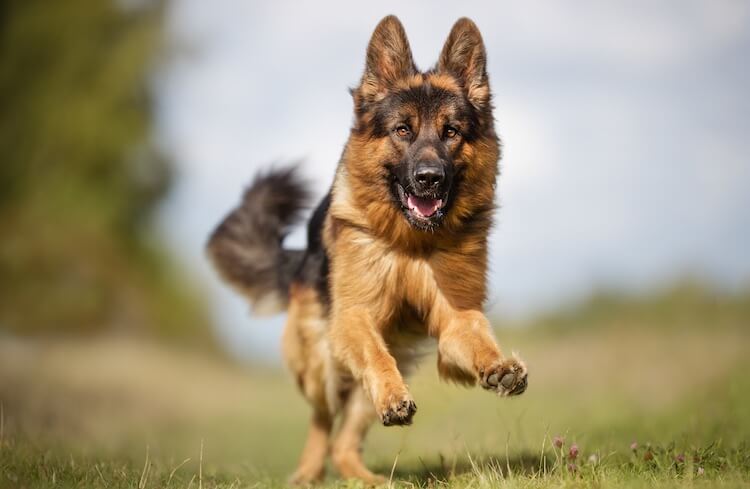
German shepherds are smart, obedient, and curious. German shepherds take longer to bond with humans than other dog breeds, but once friendships are forged, the dogs are highly loyal to their owners.
The German shepherd is a sensitive breed that hates being left alone. When nervous or upset, German shepherds display destructive behaviors, such as scratching and biting furniture.
German shepherds are vocal dogs with a loud, ferocious bark, so they’re not an ideal pet for families with babies or nervous children.
German shepherds are best suited to families with teenage children or couples who are able to spend a lot of time with their pet.
Taking Care of a German Shepherd Dog
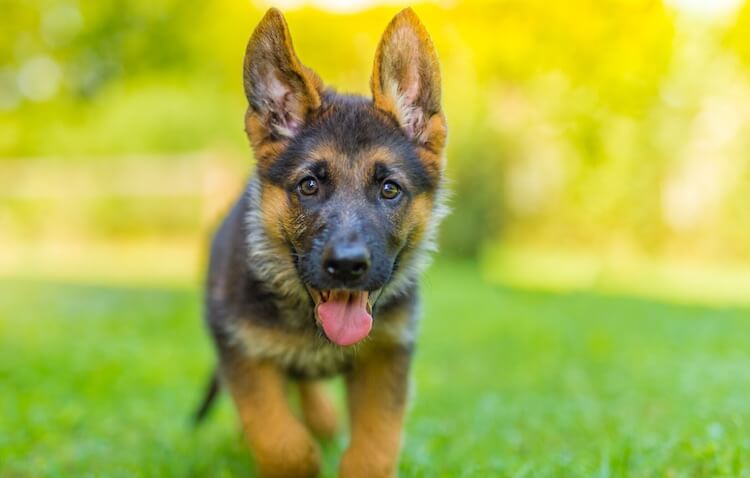
From Adobe Stock
German shepherds are easy to care for, but the dogs require a lot of attention and are highly active.
Feed your German shepherd a healthy, high-protein diet and take the dog for long walks.
Regularly brush your German shepherd’s teeth and coat, and contact your veterinarian if you notice anything unusual, like missing fur or bleeding gums.
Food Needs
German shepherds have big appetites, requiring a daily intake of 1740–2100 calories. The average adult German shepherd requires between 2.5 and 3.5 cups of nutritious kibble every day.
Adjust portions based on the size, age, and activity level of the dog, and the calorie density of the food.
Feed German shepherds a combination of wet and dry food with the correct nutritional profile to keep the dogs healthy and free from bone growth issues.
Buy dog food designed for large breed dogs, even when feeding a German shepherd puppy.
German shepherds need to grow slowly to avoid joint problems later in life, and foods for small breed puppies are unsuitable because they’re designed to promote fast growth.
A raw food diet is a good option for German shepherds because it removes a lot of unnecessary carbohydrates and provides a high percentage of protein, vitamins, and minerals needed for healthy growth.
Grooming Needs
German shepherds have high grooming needs due to their thick double coats, but brushing an obedient German shepherd is easy. This is especially true for long-haired German shepherds.
Brush your German shepherd three or four times per week to remove loose hairs and maintain soft, shiny fur.
To groom your German shepherd, remove the dog’s collar and run a slick brush down the dog’s back, from head to tail, in the direction that the fur grows.
Repeat until the brush is no longer picking up hair, then move onto the dog’s hips, tail, belly, and legs.
Alongside brushing, German shepherds need to be bathed once per month to thoroughly clean the fur.
Don’t bathe a German shepherd more than twice per month, as overbathing strips the natural oils from the dog’s coat.
Exercise Needs
German shepherds are active, energetic dogs that need at least two hours of exercise per day, ideally split into two or three separate walks.
Walking isn’t the only exercise you can do with a German shepherd. Because German shepherds are an intelligent breed, they’re ideal dogs for agility activities like herding and tracking.
Off-lead exercise, playtime, and training add variety to routine daily walks.
German shepherds have high exercise needs, so the dogs are best suited to homes with medium-to-large backyards rather than apartments with no backyard.
However, German shepherds can still live in apartments as long as the dogs are taken for frequent walks to prevent restlessness.
Mental Needs
The German shepherd is a smart dog that needs lots of mental stimulation throughout the day. Because German shepherds were originally bred to be working dogs, they have a lot of intelligence that should be put to use.
Mental exercise and brain games help to keep a German shepherd mentally fit. Training and playtime should be a big part of your German shepherd’s daily routine.
Toys are a good source of mental stimulation for German shepherds, especially interactive puzzle toys that present a challenge in return for a treat.
Tug toys and chew toys, flying discs, and tennis balls are also good choices for keeping a German shepherd mentally stimulated.
Common Health Concerns
German shepherds are prone to a number of health conditions, including:
- Hip dysplasia: a hereditary condition caused by incorrect development of the hip joint. Improper nutrition, obesity, and certain types of exercise worsen hip dysplasia. Dogs with hip dysplasia show a decreased range of motion and decreased activity. Hip dysplasia is treated with lifestyle changes or surgery, depending on severity
- Elbow dysplasia: a similar condition caused by poor-fitting elbow sockets. Symptoms are similar to hip dysplasia. Dogs with elbow dysplasia may point their front paws outwards or hold their elbows at an unnatural angle. Lifestyle changes and surgery are common treatments
To avoid buying a dog that develops hereditary conditions like hip and elbow dysplasia, look for breeders who can prove through health screening that the parent dogs don’t have these conditions.
How to Train a German Shepherd
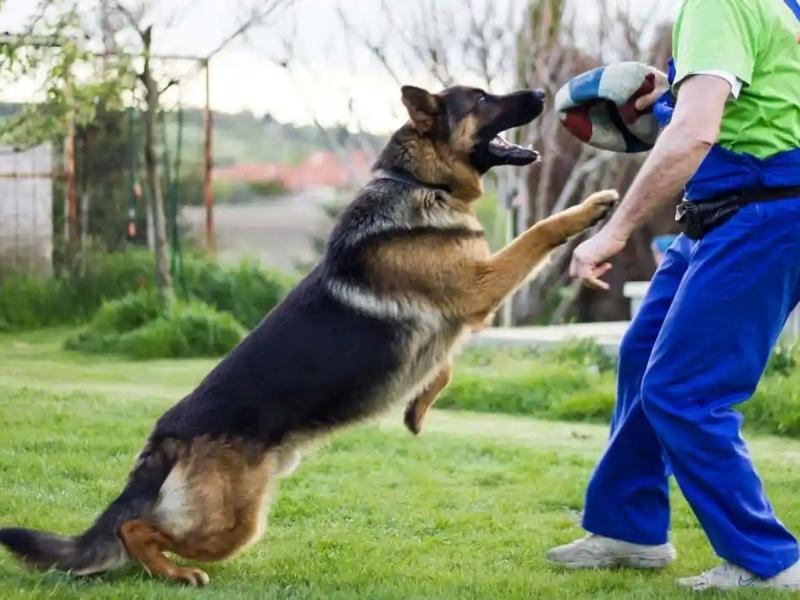
From Adobe Stock
German shepherd training is easy and they enjoy learning new tricks. You can train German shepherd puppies starting as young as seven weeks old.
Begin by teaching your German shepherd practical commands, like “sit,” “down,” and “stay,” with one-minute training sessions.
Leash train your dog as soon as possible, using treats as a reward. Toilet train your dog if wasn’t already trained as a young puppy.
When your dog is 10 weeks old, move on to more challenging commands, like “wait,” “spin,” and “bark.”
Socialize your dog by introducing it to new places and people, offering positive reinforcement for appropriate behavior.
German shepherds forget everything they’ve learned without daily training. Stick to a daily training schedule, with positive, reward-based training.
Avoid harsh punishments, which will make your dog fearful of you.
German Shepherd Price
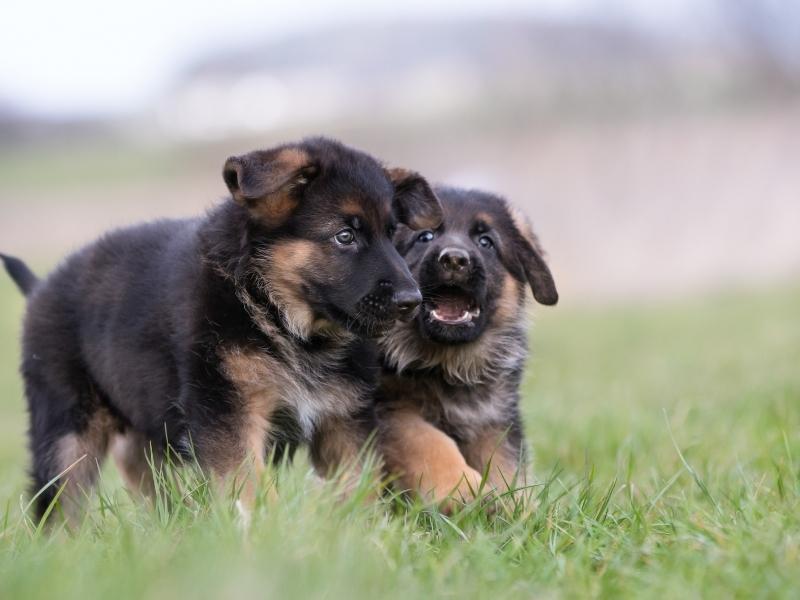
From Adobe Stock
German shepherds are expensive, sought-after, purebred dogs. The most expensive German shepherds are those sold by responsible breeders, who breed dogs based on good health and beautiful appearance.
How Much is a German Shepherd?
A German shepherd costs $800–$1,500. The price of a German shepherd depends on the dog’s age, local competition among breeders, and whether the dog has any rare or unusual features.
Adopting a German Shepherd is cheaper than buying one — adoption usually costs $200–$350 — but most German shepherds up for adoption are adults and/or have behavior problems.
German shepherd puppies cost more than German shepherd adults because owners can enjoy the special experience of watching puppies grow into adult dogs.
Rare-color German shepherds, such as silver or white German shepherds, are more expensive because of their uniqueness.
How Much Does it Cost to Raise a German Shepherd?
The initial cost of a German shepherd’s toys, vet bills, bedding, food, training classes, leash, and other pet supplies is $350–$600.
The cost per month of owning a German shepherd is about $85–$125, for grooming, healthcare, food, and new toys.
German Shepherd FAQs
- How do you discipline a German shepherd puppy?
- Are German shepherds good with kids?
- Can German shepherds be friendly to strangers?
- Can you train a German shepherd not to bark?
- Will German shepherds turn on their owners?
- Should I get a German shepherd as my first dog?
- Do German shepherds bark a lot?
- Are German shepherds easy to train?
- Do German shepherds like to cuddle?
- Are German shepherds aggressive?
- Is a German shepherd a good family dog?
Should You Get a German Shepherd?
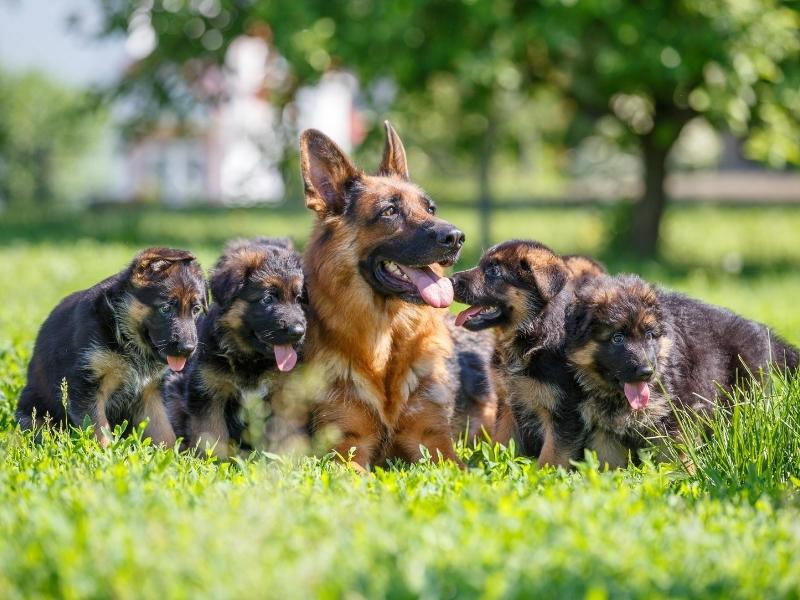
From Adobe Stock
German shepherds are beautiful, energetic, highly intelligent dogs, but they’re not ideal for all homes or lifestyles.
German Shepherds are Suitable for:
German shepherds are suitable for families with old children or adult couples with plenty of time to dedicate to their pet.
Homes with backyards are better than apartments because German shepherds are big dogs with lots of energy.
Because German shepherds are sociable, needy dogs, they’re ideal for households where at least one person is at home most of the day.
People who are prepared to regularly groom, play with, train, and bond with their pet make good German shepherd owners.
If you are thinking about getting a German shepherd, check out some popular German shepherd names.
German Shepherds are NOT Suitable for:
German shepherds are not suitable for owners who work long shifts away from home, as the dogs are known to be destructive when left alone for long periods.
German shepherds also aren’t suitable for people with mobility problems, inactive people, or people who don’t have time to exercise their dogs for at least two hours every day.
People looking for a low-commitment dog shouldn’t buy a German shepherd.
There are also a lot of German shepherd mixes that might share some of your preferred German shepherd traits with other positive traits of other breeds if you think a German shepherd isn’t suitable for you.




I have a one year old, how many meals should I feed each day? thanks
Hi Saadon, at one year of age, you can transition to feeding two meals each day (morning and evening).
Hi, I have a German Shepherd Husky mix. She looks more like a German Shepherd but has a husky tail. Do you think she is 50/50 mix or more % of one breed? She also has shorter hair but a little bit long!
I came home today and my German Shepard (1-1/2 yr. old) is refusing to go out to the backyard as if she is terrified about something. I have a large flag in the back but it has never bothered her before. She looks out the backdoor like she’s looking for something or someone. I live in a new sub division but in a small town in Texas. We do have occasional coyotes. But this has to be something that happened while she was inside while we were gone about 3 hours. Any ideas? We’re a little worried.